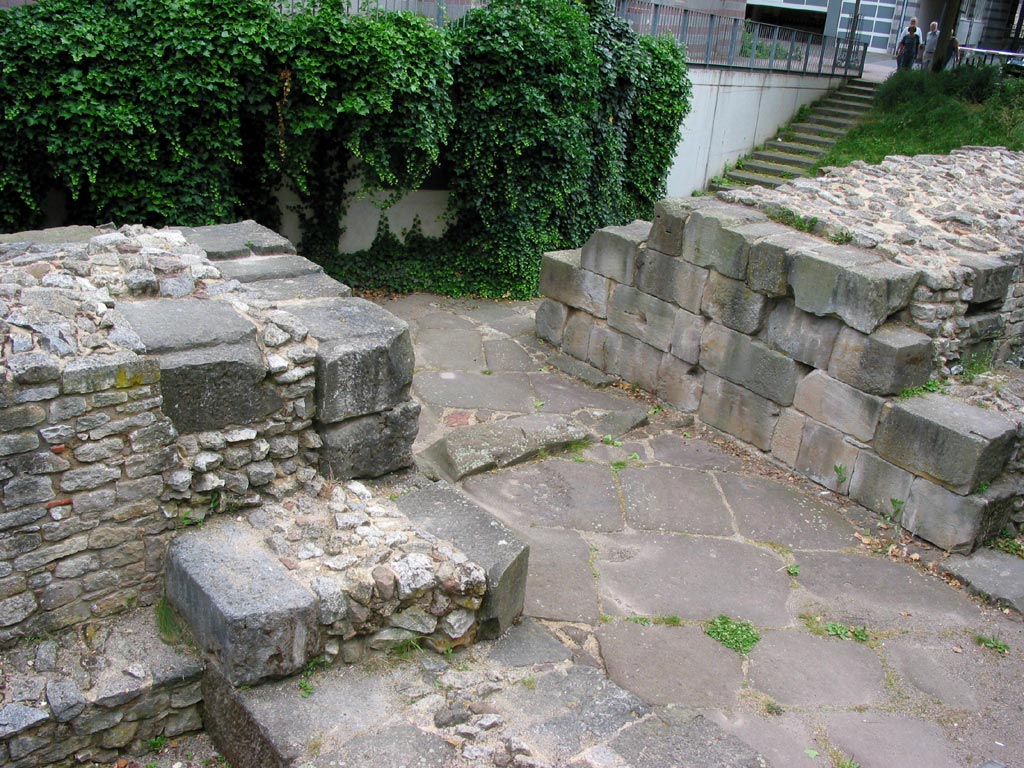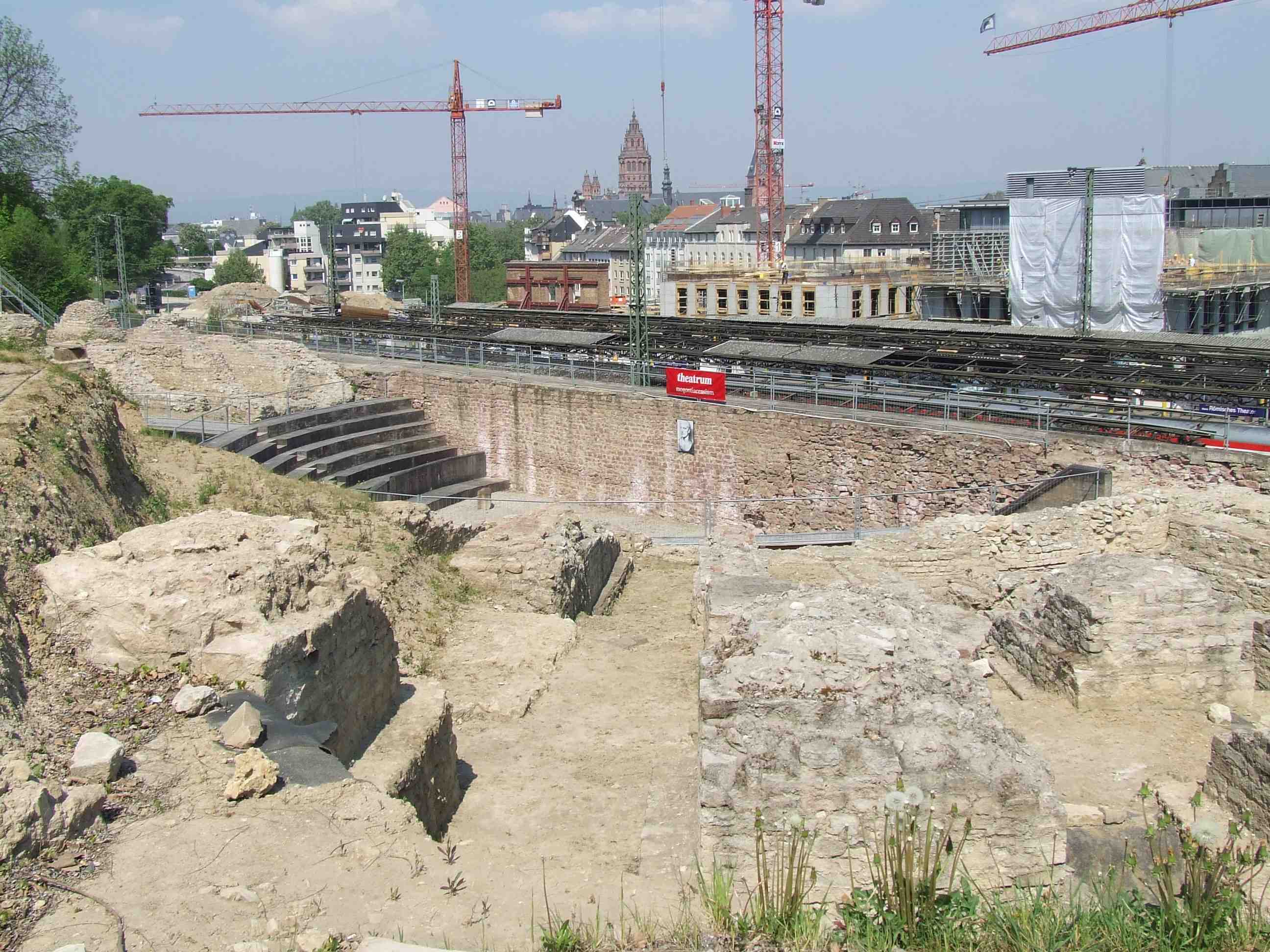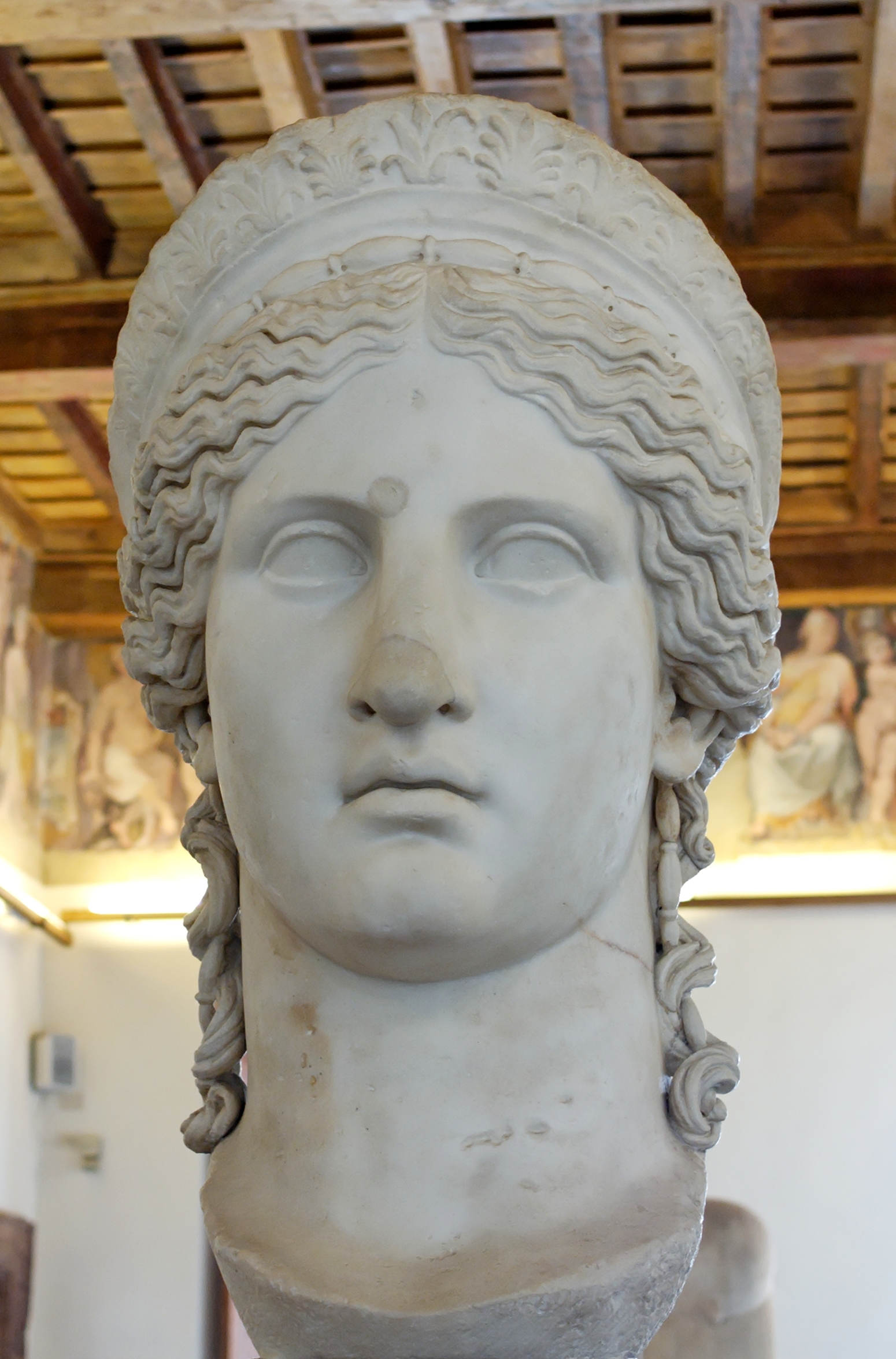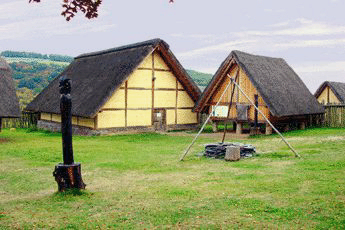|
Mogontiacum
''Mogontiacum'' (also ''Moguntiacum'') is the Latin name of today's city of Mainz, which it bore during its almost 500 years as part of the Roman Empire. ''Mogontiacum'' had its origins in the legionary camp built by Drusus in 13/12 BCE, which was strategically located on a above the Rhine and opposite the mouth of the Main on the . The civilian settlements ('' vici'') in the vicinity of the camp, which spread down the Rhine, quickly grew together to form a larger, urbanised settlement. However, unlike ''Colonia Claudia Ara Agrippinensium'' (Cologne) or ''Augusta Treverorum'' (Trier), ''Mogontiacum'' was primarily a military centre until the second half of the 4th century and was apparently not a '' colonia'' either. As a result, the city never had the urban character of the other large Roman cities in Germany. Nevertheless, several monumental buildings were also erected here, as ''Mogontiacum'' was the provincial capital of the Roman province of ''Germania'' '' Superior'' with ... [...More Info...] [...Related Items...] OR: [Wikipedia] [Google] [Baidu] |
Mainz
Mainz (; #Names and etymology, see below) is the capital and largest city of the German state of Rhineland-Palatinate, and with around 223,000 inhabitants, it is List of cities in Germany by population, Germany's 35th-largest city. It lies in the Frankfurt Rhine-Main, Rhine-Main Metropolitan Region—Germany's second-largest metropolitan region after Rhine-Ruhr—which also encompasses the cities of Frankfurt am Main, Wiesbaden, Darmstadt, Offenbach am Main, and Hanau. Mainz is located at the northern end of the Upper Rhine Plain, on the left bank of the Rhine. It is the largest city of Rhenish Hesse, a region of Rhineland-Palatinate that was historically part of Grand Duchy of Hesse, Hesse, and is Rheinhessen (wine region), one of Germany's most important wine regions because of its mild climate. Mainz is connected to Frankfurt am Main by the Rhine-Main S-Bahn rapid transit system. Before 1945, Mainz had six boroughs on the other side of the Rhine (see: :de:Rechtsrheinische St ... [...More Info...] [...Related Items...] OR: [Wikipedia] [Google] [Baidu] |
Mainz-Weisenau
Mainz (; see below) is the capital and largest city of the German state of Rhineland-Palatinate, and with around 223,000 inhabitants, it is Germany's 35th-largest city. It lies in the Rhine-Main Metropolitan Region—Germany's second-largest metropolitan region after Rhine-Ruhr—which also encompasses the cities of Frankfurt am Main, Wiesbaden, Darmstadt, Offenbach am Main, and Hanau. Mainz is located at the northern end of the Upper Rhine Plain, on the left bank of the Rhine. It is the largest city of Rhenish Hesse, a region of Rhineland-Palatinate that was historically part of Hesse, and is one of Germany's most important wine regions because of its mild climate. Mainz is connected to Frankfurt am Main by the Rhine-Main S-Bahn rapid transit system. Before 1945, Mainz had six boroughs on the other side of the Rhine (see: :de:Rechtsrheinische Stadtteile von Mainz). Three have been incorporated into Wiesbaden (see: :de:AKK-Konflikt), and three are now independent. Mainz ... [...More Info...] [...Related Items...] OR: [Wikipedia] [Google] [Baidu] |
Drususstein
The Drususstein (Drusus stone) is a nearly 20 metres high masonry block of Roman origin on the grounds of the citadel of Mainz, Germany. It was originally cased in marble. Researchers now largely accept that this is the structural remnant of the cenotaph mentioned by writers such as Eutropius and Suetonius, erected in 9 BC by Roman troops in honour of the deceased general Drusus, in Mogontiacum (now Mainz). During the early days of the Principate, the Drususstein was the starting point for elaborate memorial services in honour of Drusus, and the centre of the imperial cult in Mogontiacum. A procession road linked it to the theatre of Mogontiacum, which contained approximately 12,000 seats, making it the largest known theatre north of the Alps. It may have hosted a part of the annual ceremonies at the day of Drusus' death, and probably also at his birthday. After being robbed of its marble casing in the early Middle Ages, the Drususstein served as a watchtower in the fortifi ... [...More Info...] [...Related Items...] OR: [Wikipedia] [Google] [Baidu] |
Roman Theatre (Mainz)
The Roman Theatre in Mainz, Rhineland Palatinate (ancient '' Mogontiacum'') was excavated in the late 1990s. It is located immediately next to the Mainz Römisches Theater station and was once the largest Roman theatre north of the Alps, with a diameter of 116 metres, a stage-width of 42 metres, and a capacity of roughly ten thousand people. History Mogontiacum owed its significance to its location at the meeting point of the Main and the Rhine. The city provided a convenient base for the defense of the nearby border of the Roman Empire, the ''limes'', and for the organisation of military campaigns against the Germani. As a result, a double legionary camp was built on the site in 13/12 BC, which remained in place until some time after AD 350. Over time a civilian settlement (Latin ''vicus'') also developed on the site, which became the provincial capital of the newly created province of Germania Superior around AD 80. In this city, a Roman theatre was built, which was probab ... [...More Info...] [...Related Items...] OR: [Wikipedia] [Google] [Baidu] |
Germania Superior
Germania Superior ("Upper Germania") was an imperial province of the Roman Empire. It comprised an area of today's western Switzerland, the French Jura and Alsace regions, and southwestern Germany. Important cities were Besançon ('' Vesontio''), Strasbourg ('' Argentoratum''), Wiesbaden ('' Aquae Mattiacae''), and Germania Superior's capital, Mainz ('' Mogontiacum''). It comprised the Middle Rhine, bordering on the '' Limes Germanicus'', and on the Alpine province of Raetia to the south-east. Although it had been occupied militarily since the reign of Augustus, Germania Superior (along with Germania Inferior) was not made into an official province until c. 85 AD. Origin Initial Roman involvement The terms, "Upper Germania" and "Lower Germania" do not appear in the '' Commentarii de Bello Gallico'' of Julius Caesar, yet he writes about reports that the people who lived in those regions were referred to as "Germani" locally, a term used for a tribe that the Romans cal ... [...More Info...] [...Related Items...] OR: [Wikipedia] [Google] [Baidu] |
Nero Claudius Drusus
Nero Claudius Drusus Germanicus (38–9 BC), commonly known in English as Drusus the Elder, was a Roman general and politician. He was a patrician Claudian but his mother was from a plebeian family. He was the son of Livia Drusilla and the stepson of her second husband, the Emperor Augustus. He was also brother of the Emperor Tiberius; the father of the Emperor Claudius and general Germanicus; paternal grandfather of the Emperor Caligula, and maternal great-grandfather of the Emperor Nero. Drusus launched the first major Roman campaigns across the Rhine and began the conquest of Germania, becoming the first Roman general to reach the Weser and Elbe rivers. In 12 BC, he led a successful campaign into Germania, subjugating the Sicambri. Later that year he led a naval expedition against Germanic tribes along the North Sea coast, conquering the Batavi and the Frisii, and defeating the Chauci near the mouth of the Weser. In 11 BC, he conquered the Usipetes and the Marsi, exte ... [...More Info...] [...Related Items...] OR: [Wikipedia] [Google] [Baidu] |
Main (river)
The Main () is the longest tributary of the Rhine, one of the major List of rivers of Europe, European rivers. It rises as the White Main in the Fichtel Mountains of northeastern Bavaria and flows west through central Germany for to meet the Rhine below Rüsselsheim, Hesse. The cities of Mainz and Wiesbaden are close to the confluence. The largest cities on the Main are Frankfurt am Main, Offenbach am Main and Würzburg. It is the longest river lying entirely in Germany (if the Weser-Werra are considered separate). Geography The Main flows through the north and north-west of the States of Germany, state of Bavaria and then across southern Hesse; against the latter it demarcates a third state, Baden-Württemberg, east and west of Wertheim am Main, the northernmost town of that state. The upper end of its drainage basin, basin opposes that of the Danube where the watershed is recognised by natural biologists, sea salinity studies (and hydrology science more broadly) as the Eu ... [...More Info...] [...Related Items...] OR: [Wikipedia] [Google] [Baidu] |
Germanic Peoples
The Germanic peoples were tribal groups who lived in Northern Europe in Classical antiquity and the Early Middle Ages. In modern scholarship, they typically include not only the Roman-era ''Germani'' who lived in both ''Germania'' and parts of the Roman Empire, but also all Germanic speaking peoples from this era, irrespective of where they lived, most notably the Goths. Another term, ancient Germans, is considered problematic by many scholars since it suggests identity with present-day Germans. Although the first Roman descriptions of ''Germani'' involved tribes west of the Rhine, their homeland of ''Germania'' was portrayed as stretching east of the Rhine, to southern Scandinavia and the Vistula in the east, and to the upper Danube in the south. Other Germanic speakers, such as the Bastarnae and Goths, lived further east in what is now Moldova and Ukraine. The term ''Germani ''is generally only used to refer to historical peoples from the 1st to 4th centuries CE. Different ac ... [...More Info...] [...Related Items...] OR: [Wikipedia] [Google] [Baidu] |
Aresaces
The Aresaces were Belgic tribe. They were closely related to, and probably originally part of, the Treveri. They inhabited the left bank of the Rhine in the Mainz -Bingen area, which was once the easternmost part of Treveran territory. Written sources The Aresaces are not mentioned by ancient writers, such as geographers or Julius Caesar, but are known from three inscriptions dating to the 1st and 2nd centuries CE. Two of these come from Rhenish Hesse, while the third is from Augusta Treverorum (Trier), the capital of the Treveri. A grave monument from Mainz-Weisenau that identifies the two deceased children as Treveri has been explained as evidence that the Aresaces continued to regard themselves as a subdivision of the Treveri. Another Celtic tribe in Rhenish Hesse, known from an inscription as well as ancient literature, was the Cairacates. Settlement area of the Aresaces According to current scholarship, the Aresaces would have been organized as a ''pagus'' or sub-u ... [...More Info...] [...Related Items...] OR: [Wikipedia] [Google] [Baidu] |
Colonia Claudia Ara Agrippinensium
Colonia Claudia Ara Agrippinensium was the Roman colony in the Rhineland from which the city of Cologne, now in Germany, developed. It was usually called ''Colonia'' (colony) and was the capital of the Roman province of Germania Inferior and the headquarters of the military in the region. With administrative reforms under Diocletian it became the capital of Germania Secunda. During the second and mid-third centuries, around 20,000 people lived in the city. Many artefacts from the ancient city survive, including the arch of the former city gate with the inscription 'CCAA', which is today housed in the Romano-Germanic Museum. Historical background ''Oppidum Ubiorum'' (Latin city of Ubii), ''Ara Ubiorum'' and ''Apud Aram Ubiorum'' A Germanic tribe known as the Eburones had originally inhabited the present-day Cologne Lowland. But they were wiped out in a war of reprisal carried out by Julius Caesar. In 38 BC, the Germanic tribe known as the Ubii, who inhabited the right ... [...More Info...] [...Related Items...] OR: [Wikipedia] [Google] [Baidu] |
List Of Latin Place Names In Continental Europe, Ireland And Scandinavia
This list includes European countries and regions that were part of the Roman Empire, or that were given Latin place names in historical references. As a large portion of the latter were only created during the Middle Ages, often based on scholarly etiology, this is not to be confused with a list of the actual names modern regions and settlements bore during the classical era. Background Until the Modern Era, Latin was the common language for scholarship and mapmaking. During the 19th and 20th centuries, German scholars in particular have made significant contributions to the study of historical place names, or ''Ortsnamenkunde''. These studies have, in turn, contributed to the study of genealogy. For genealogists and historians of pre-Modern Europe, knowing alternate names of places is vital to extracting information from both public and private records. Even specialists in this field point out, however, that the information can be easily taken out of context, since there is a gre ... [...More Info...] [...Related Items...] OR: [Wikipedia] [Google] [Baidu] |
Treveri
The Treveri (Gaulish language, Gaulish: *''Treweroi'') were a Germanic peoples, Germanic or Celts, Celtic tribe of the Belgae group who inhabited the lower valley of the Moselle (river), Moselle in modern day Germany from around 150 BCE, if not earlier, until their displacement by the Franks. Their domain lay within the southern fringes of the ''Silva Arduenna'' (Ardennes Forest), a part of the vast Silva Carbonaria, in what are now Luxembourg, southeastern Belgium and western Germany; its centre was the city of Trier (''History of Trier, Augusta Treverorum''), to which the Treveri give their name. Celtic languages, Celtic in language, according to Tacitus they claimed Germanic descent.Tacitus writes, "The Treveri and Nervii are even eager in their claims of a German origin, thinking that the glory of this descent distinguishes them from the uniform level of Gallic effeminacy." ''#Germania, Germania'' s:Germania#XXVIII, XXVIII. They contained both Gauls, Gallic and Germanic influenc ... [...More Info...] [...Related Items...] OR: [Wikipedia] [Google] [Baidu] |











